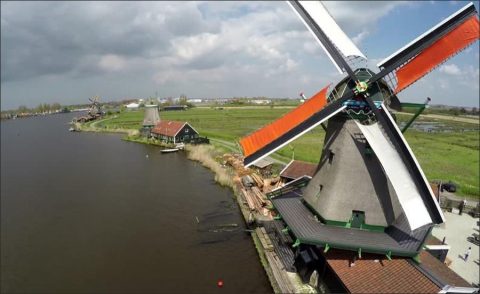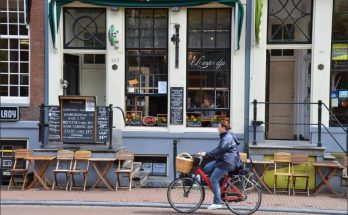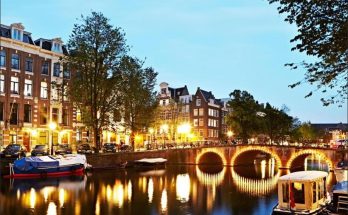If you wished to survey the whole of the Netherlands, to have a bird’s eye view of the entire country, you would in these days look down from the observer’s seat of a flying machine, or from the gondola of an airship, flying over the country, and you would be able in this way to obtain a rapid and general impression of the territory beneath you.
The greatest length of the Netherlands, from North to South, is over 190 miles, and its extreme breadth from its sea boundary in the West to its land boundary in the East, is nearly 125 miles. The whole country has a total area of little more than 15000 square miles, and does not cover more than a very modest 1/300th part of the continent of Europe, being one of the last in the list of European states according to their size.
Such a territory could actually, thanks to modern aviatic possibilities, be seen in its entirety from one horizon to the other, an advantage — you will admit — for the curious observer, who, with an all-embracing glance wishes to survey this country, and note its geographical lines as well as the diversity of its grounds.
For in this way this exalted observer would recognize beneath him one of the most peculiar types of land, such as no other air excursion above any other land in the world could show him. Beneath him he will see an almost perfectly flat stretch of land gradually sloping from the South-east towards the West and North, so regularly indeed, that the fall is almost imperceptible, until it finally descends so low that the green plains, intersected by innumerable rivers, canals and ditches of all kinds, lie lower than the sea, against whose inroads it is only protected by an irregular chain of dunes and dykes’ walls!
Along The North Sea Coast
The white breakers, in perpetual motion, stretch far beyond the whole West and North coast; the observer aloft, on seeing the breakers, will immediately recognize this to be the dangerous type of coast to be met with elsewhere: a shallow coast full of sandbanks and shoals, almost inaccessible from the sea because of the very gradual rise of the sand bottom towards the land.
The dunes bulge out their sandy tops, sparsely planted with helm grass, like a humble buttress against the sea; their breadth is unequal along the coast. In certain places where the narrow strip of dunes threatened to be completely swept by the landward surging sea, long and missive sea dykes bar the way, as, for instance, in the Southern islands, forming part of the province of Zealand, where the Westkappel dyke protects’ the island of Walcheren, and more northerly on the coast of North Holland, where the Hondsbosch sea wall covers a former opening in the dunes.
In other places again he will see the girdle of dunes narrowing down ominously, and artificial reinforcements of the shore have been constructed in order to prevent any further erosion of the shore and of the dunes behind it, as can be seen along the coast of the so-called Westland, which by means of its piers or breakwaters has to protect the greater part of the mainland of South Holland, and between Petten and the northern portion of North Holland near Huisduinen, where a long row of stone piers runs into the sea from the shore at intervals of two or three hundred yards.
From such an elevated position the spectator will easily see that it has not everywhere been possible to protect the low-lying land against the inroads of the turbulent sea. The strip of dunes in the North and South shows a very fretted line; the natural sea wall of the dunes, thrown up by the treacherous and fickle sea, as it were, against its own capricious moods, seems to be too low and too narrow to turn the wild attacks of the waters at spring tide or in a storm from the North or the West. What a number of breaches and openings gape threateningly here and there.
The coast to the north of North Holland, Friesland and Groningen has even assumed the shape of a narrow chain of islands, which bear the names of Texel, Vlieland, Terschelling, Ameland, Schiermonnikoog and Rottum. They are formed of dunes rising but a few meters above the sea level, bordered by a deep foreshore, but severed from the mainland by the shallow Wadden Sea.
Following the coast line we find the sea water glistening below in three large gulfs; the Dollart and the Lauwerzee penetrating into the land on either side of the province of Groningen, and the third inland sea, the largest of the three, the Zuider Zee, which covers some 875.000 acres.
The south-western coast line is broken by the wide mouths of the three large rivers, the Rhine, Maas and Scheldt; these rivers wind their way from the South and East to the western sea coast where, with the ready aid of the greedy, land-grasping sea, they form larger and smaller islands which belong to the provinces of South Holland and Zealand.



